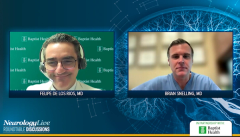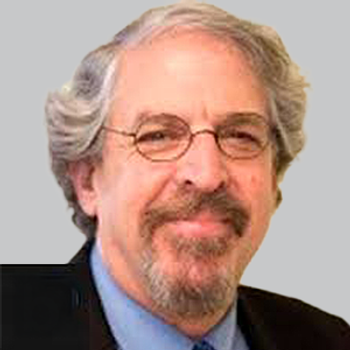
Emerging Neuroprotective Agents for Stroke Care

The conversation centers around the pursuit of effective neuroprotective agents in stroke, the challenges of clinical trial design, and what could make future therapies succeed. [WATCH TIME: 5 minutes]
WATCH TIME: 5 minutes
Across the evolving landscape of stroke treatment, advancements in imaging, intervention, and digital technology continue to redefine what is possible for patients. In this special panel discussion series, neurosurgeon Brian Snelling, MD, and neurologist Felipe De Los Rios, MD, share their expertise from
Over five focused conversations, they discuss the major shifts shaping acute stroke management—from expanding thrombectomy eligibility and integrating artificial intelligence into clinical workflows, to the promise of neuroprotective agents, modern strategies for recovery and prevention, and the optimization of stroke systems of care. Together, their insights provide an inside look at how data-driven innovation is transforming outcomes for patients across every stage of stroke treatment.
In this conversation, Dr. De Los Rios outlines the historical difficulty of translating neuroprotective agents from concept to clinical success, referencing past disappointments and the renewed optimism around new mechanisms and delivery strategies. Dr. Snelling describes the logistical and operational hurdles of testing these drugs in the high-pressure thrombectomy environment, where timing and coordination are critical.
Both physicians discuss recent and ongoing trials, including ESCAPE-NEXT and novel stem cell approaches, as well as the potential for future agents to complement thrombectomy or thrombolysis by preserving viable tissue. Their discussion underscores that while neuroprotection remains an elusive goal, it continues to be one of the most important frontiers in acute stroke care.
Transcript edited for clarity.
Felipe De Los Rios, MD: These are all excellent questions. Neuroprotection isn’t a new concept—it’s something we’ve been pursuing for a long time. Over the years, we’ve had several agents that looked promising in early studies, and everyone was hopeful they would translate into clinical success. Magnesium, for example, showed early potential, but when it got to phase 3 randomized trials, the benefit just wasn’t there.
Despite that, there’s renewed enthusiasm in this space. A number of newer agents and novel strategies are being tested now that weren’t available to us before. These drugs are based on different mechanisms, and that gives us hope that maybe one of them will finally make a difference. We’re all rooting for these to succeed, but neuroprotection remains an elusive goal—we haven’t yet found an agent that truly works in practice.
Still, we’re very optimistic. The ultimate idea is to extend the treatment window—to “freeze” the area of stroke, preserving tissue that might otherwise progress to irreversible injury, so that patients do better with the therapies we already have. If one of these agents can also reduce complications, that would be a major step forward. But we need those phase 3 data first before we can say that neuroprotection is finally here.
Brian Snelling, MD: That’s a great point. The recent ESCAPE trials were, I think, our best hope yet for solving what many people in acute stroke call the “Holy Grail”—stopping cells from dying in real time. The results were disappointing, but I don’t think that means the concept is dead. There are still multiple companies going after this, and we’re involved in several active studies here at Boca and others at the main Baptist Hospital campus that are testing new neuroprotective or adjunctive therapies.
The big challenge isn’t just whether the drug works—it’s whether we can realistically deliver it in the acute stroke workflow. These studies are hard to run. Stroke is an emergency, everything moves quickly, and the treatment windows are measured in minutes. So identifying the right patient, completing consent, randomizing them, and then administering the drug—all before first pass thrombectomy—is incredibly difficult.
For some of these trials, the protocol requires the agent to be given before the first pass or immediately after reperfusion. But practically speaking, that’s almost impossible in a busy, emergent environment. Everyone is trying to move the patient through imaging, anesthesia, and procedure prep at lightning speed. Adding a research protocol into that mix is tough. Even for us, in an experienced comprehensive stroke center, it’s been a challenge to get drugs administered within the ideal time window.
Felipe De Los Rios, MD: Exactly. The logistics can really limit what’s possible. Take the FAST-MAG trial from years ago—that was such an impressive effort by Jeff Saver and his team. They were administering magnesium sulfate in the ambulance before patients even arrived at the hospital. That worked because magnesium is extremely safe, so you could justify giving it in the prehospital setting. But newer agents don’t always have that kind of safety data yet.
That’s part of the reason why these phase 3 trials are so difficult. For something truly neuroprotective, you’d ideally want to start the therapy right away—potentially even before hospital arrival—but to do that, you need robust safety evidence and logistical infrastructure that most systems don’t yet have. For now, we’re focusing on how to get these agents administered as early as possible once patients arrive.
Brian Snelling, MD: And even when we can get them on board quickly, we run into the problem of timing relative to reperfusion. For instance, some protocols want dosing immediately after the vessel is reopened, which is often too late to change the outcome if tissue is already infarcted. Others want it before the procedure, but that’s not feasible when the whole team is racing to the angio suite.
We’ve also worked with trials involving intra-arterial delivery of bone marrow–derived stem cells—infused directly into the M1 segment after thrombectomy. That approach makes a lot of biological sense: you’re delivering regenerative material right to the affected territory. But again, it’s logistically complicated. It adds procedure time, it requires specific catheter setups, and it’s only appropriate for select patients. So even though it’s exciting science, it’s difficult to scale.
Felipe De Los Rios, MD: Absolutely. And one of the lessons from these studies is that we need to think creatively about trial design. Maybe instead of trying to fit these therapies into the narrow thrombectomy workflow, we look at subgroups—patients who aren’t candidates for reperfusion or who present too late for thrombectomy but still have viable tissue. Neuroprotection could be particularly valuable there, because those patients currently have no treatment options.
But I do think it’s important to emphasize that while no drug has yet proven effective, the momentum in this field is real. There are several promising candidates with new mechanisms—agents that target mitochondrial stability, inflammation, and excitotoxicity differently from older compounds. The preclinical data are strong. Whether they can translate to meaningful clinical benefit will come down to execution: the right population, the right dose, and the right timing.
Brian Snelling, MD: And that’s the key—timing. Even when a drug looks good on paper, if you can’t deliver it soon enough, you’re not going to see the effect you want. That’s part of why the ESCAPE-NEXT results were disappointing: they were scientifically solid, but practically very difficult to execute.
Still, we have to keep trying. Every advance we’ve made in stroke—from thrombolytics to thrombectomy—started with years of negative trials before we got it right. Neuroprotection will probably follow the same trajectory. It’s going to take a combination of smart study design, practical logistics, and maybe even AI-assisted triage to identify eligible patients fast enough.
Felipe De Los Rios, MD: Exactly. It’s the frontier of acute stroke care. I think eventually we’ll get there—whether through a drug that stabilizes the ischemic penumbra, a cell-based therapy, or a combination of both. It’s not going to happen overnight, but we’re making steady progress. The key is persistence and continuing to learn from every trial, even the ones that fail.
Brian Snelling, MD: Completely agree. The interest from both academic centers and industry shows that people still believe in the concept. It’s not about if we’ll find a neuroprotective therapy—it’s about when.
Newsletter
Keep your finger on the pulse of neurology—subscribe to NeurologyLive for expert interviews, new data, and breakthrough treatment updates.



































